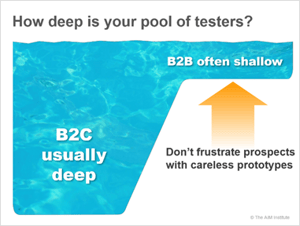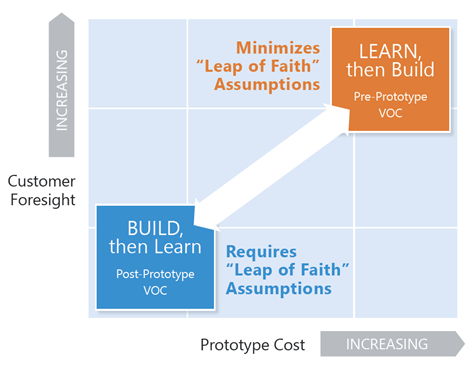B2B users risk serious problems using Lean Startup "as is."
Besides overlooking the opportunity to learn from knowledgeable B2B customers prior to building a prototype, Lean Startup suffers two more limitations in B2B use: a shallow pool of testers and unwarranted “leaps of faith.”
We’ve seen some very large B2B organizations adopt Lean Startup without the learn-then-build adjustments we suggested in the last article… with troubling consequences. One point they seem to have missed is the “depth” of their pool of prototype testers.
 If you want B2C customers to give you feedback on your new-product prototype, you’re in luck: You’ve got millions of potential testers. If you frustrate some of them with ill-conceived prototypes, no problem: Just find new testers.
If you want B2C customers to give you feedback on your new-product prototype, you’re in luck: You’ve got millions of potential testers. If you frustrate some of them with ill-conceived prototypes, no problem: Just find new testers.
But the situation is quite different for many B2B markets. In some cases, you have relatively few potential customers, and the last thing you want to do is upset them. It can often be expensive and time-consuming for them to evaluate a B2B product. Much better to interview them first to get your prototype as close as possible to what they’d like to see.
Lean Startup methodology refers to “Leap of Faith Assumptions”… a term that nicely highlights the shaky foundation of most suppliers’ hypotheses. Lean Startup wisely recommends testing assumptions and learning from customers at the first opportunity.
For most B2B suppliers, this “first opportunity” to learn comes before a prototype is created… through early voice-of-customer interviews that mine the insight and foresight of highly-knowledgeable customers. Why take a leap of faith when you could take a leap of confidence—even more quickly and cheaply?
 When considering whether you should start with a) your hypothesis and a prototype (Build), or b) voice-of-customer interviews (Learn), also consider the time and financial cost to create a prototype. In all cases, you need to conduct VOC research with potential customers. If the cost of a prototype is high and customers have a great deal of foresight, you should conduct some of this VOC before creating your first prototype or “minimally viable product.”
When considering whether you should start with a) your hypothesis and a prototype (Build), or b) voice-of-customer interviews (Learn), also consider the time and financial cost to create a prototype. In all cases, you need to conduct VOC research with potential customers. If the cost of a prototype is high and customers have a great deal of foresight, you should conduct some of this VOC before creating your first prototype or “minimally viable product.”
For more, download the AIM white paper, Lean Startup for B2B. Also check out the 2-minute video, Beware of B2C innovation shortcuts, part of the B2B Organic Growth video series by Dan Adams.
Keywords: lean startup, New Product Blueprinting, prototype, testing pool, leap of faith, voice of customer, voc
